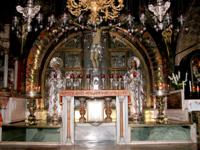 Jesus Christ was crucified on a hill called Golgotha, “The Place of the Skull.” At the time of his crucifixion in the first century it was located outside of the walls of Jerusalem. Today, the place of Christ’s crucifixion rests underneath an Orthodox Christian chapel inside the Church of the Resurrection (a.k.a. Church of the Holy Sepulchre). The rock of Golgotha that held the Precious Cross is visible underneath the chapel’s floor.
Jesus Christ was crucified on a hill called Golgotha, “The Place of the Skull.” At the time of his crucifixion in the first century it was located outside of the walls of Jerusalem. Today, the place of Christ’s crucifixion rests underneath an Orthodox Christian chapel inside the Church of the Resurrection (a.k.a. Church of the Holy Sepulchre). The rock of Golgotha that held the Precious Cross is visible underneath the chapel’s floor.The death of Jesus Christ on the Cross was a cosmic event. St. Luke describes the scene:
It was now about the sixth hour, and there was darkness over the whole land until the ninth hour, while the sun’s light failed; and the curtain of the temple was torn in two. Then Jesus, crying with a loud voice, said, “Father, into thy hands I commit my spirit!” And having said this he breathed his last. (Luke 24.44-46, RSV)
St. Matthew adds,
and the earth shook, and the rocks were split; the tombs also were opened, and many bodies of the saints who had fallen asleep were raised, and coming out of the tombs after his resurrection they went into the holy city and appeared to many. When the centurion and those who were with him, keeping watch over Jesus, saw the earthquake and what took place, they were filled with awe, and said, “Truly this was the Son of God!" (Matthew 51-54, RSV)
What effect did Christ’s death have upon us and the whole universe? Hieromonk Damascene’s article, “What Christ Accomplished on the Cross” (orthodoxinfo.com), explains the Orthodox Christian understanding of the event. Frederica Mathewes-Green’s essay, “Christ’s Death: Rescue Mission, Not Payment for Sins” (beliefnet.com), is also worth reading. My previous post on the “River of Fire” relates to the subject as well.
Copyright © 2006 by Dana S. Kees. (Photograph from the Pictorial Library of Bible Lands, Bibleplaces.com. Used by permission.)
